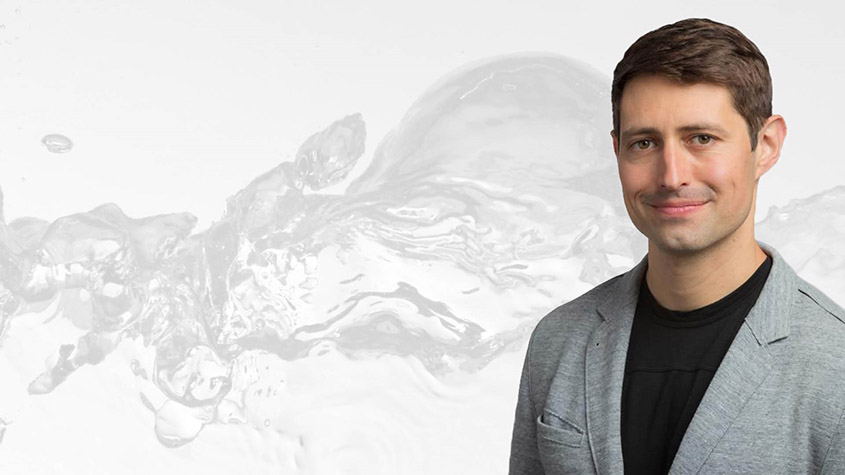Creativity and Exploration Drive Marine Energy Research
NREL’s Marine Energy Team Lead Believes 2022 Will Be Defined By Collaboration With Current and Future Industry Leaders

Mike Lawson leads the National Renewable Energy Laboratory's (NREL’s) marine energy team, which focuses on wave and water current energy research and development. We asked him where he sees marine energy going in the near future.
The entire NREL water power team and I are driven by the unrealized potential of marine energy—the potential to harness the planet’s waves, currents, and tides to generate clean, renewable energy to meet the country’s energy needs in 2022 and beyond. We know there are vast marine energy resources in the United States, and the NREL water power team is catalyzing its collective creativity and the full scope of the laboratory’s capabilities to make marine energy a viable and productive renewable energy source.
Marine energy technology developers are still designing and testing devices, and we don’t know what the ultimately successful technologies will look like or how they will operate. This unknown is why the entire marine energy community, across national labs, industry, and academia, is continuously innovating, and it’s what makes marine energy an exciting field to work in. At NREL, we are pursuing technologies that enable the growth of a thriving marine energy industry while dreaming big and researching potentially game-changing advances such as distributed embedded energy converters.
The NREL marine energy team is collaborating closely with academic, industry, and national laboratory partners to maximize the impact of our research and the laboratory’s capabilities. For example, we are leveraging decades of wind energy researchers at NREL, collaborating with Colorado State University, and strategically partnering with external stakeholders to produce a simulation tool to better model the performance of tidal turbines. Columbia Power Technologies (CPower) and NREL are working together to validate the performance of its SeaRAY autonomous wave-energy device. This project is using facilities at NREL’s Flatirons Campus to de-risk CPower’s open-ocean deployment in Hawaii and is a great example of how NREL’s facilities can be leveraged to support open-ocean testing. We also work closely with the four National Marine Renewable Energy Centers on a range of topics, from providing support for performing accredited testing of marine energy systems, to helping develop testing procedures for the PacWave wave energy test site.
I am particularly proud of our collaboration with the U.S. Department of Energy (DOE) on the Waves to Water Prize and the development of the Hydraulic and Electric Reverse Osmosis Wave Energy Converter (HERO WEC) NREL has built and tested to de-risk prize activities for competitors. The resulting device features a modular power take-off, with the capabilities to test both hydraulic and electric systems to better understand how the deployment process might vary between these types of devices. The HERO WEC will enable the team to effectively assess various aspects of the competition process, including measurement techniques. This year marks the finale of the three-year competition, which will conclude with the DRINK Stage, in which prize finalists will deploy their small, modular, wave energy powered desalination devices off the coast of North Carolina. Participating in the finale is a testament to how far the teams have come in developing their prototypes, which could, one day, provide clean drinking water for remote and coastal communities or in disaster relief scenarios. I’m inspired by how these teams were able to sustain the positive energy and enthusiasm necessary to tackle difficult problems over an extended period of time. I see hope in the creativity and persistence of these cutting-edge innovators who could be the first to bring this vital technology to market.
The same goes for the leadership role that NREL has taken in the U.S. Testing Expertise and Access to Marine Energy Research (TEAMER) program, funded by DOE’s Water Power Technologies Office. TEAMER provides technology developers access to NREL experts, their technical expertise, and the laboratory’s testing capabilities, along with those of other supporting institutions. NREL sits on the TEAMER board, and over the last two years NREL has provided R&D support to 15 marine energy technology developers in the areas of numerical modeling, laboratory testing, and economic analysis. We are excited about the opportunity to work with more technology developers under the TEAMER program in 2022 and beyond.
All these accomplishments would not have been possible without our growing team of researchers and staff at NREL. The marine energy team has grown to over 40 scientists, engineers, and support staff all focused on developing marine energy technologies and transforming the U.S. energy system for the benefit of communities across the nation and the world. We are all looking forward to helping solve the R&D challenges that need to be overcome to realize the success of the marine energy industry in 2022 and beyond.
Learn more about NREL’s marine energy research and sign up for NREL's water power newsletter.
Read NREL Hydropower Technical Lead Greg Stark's editorial on hydropower.
Last Updated May 28, 2025
